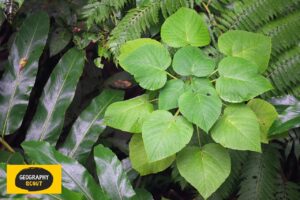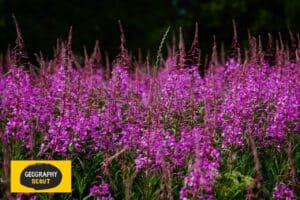In Australia, Even Our Plants Can Kill You
In Australia, Even Our Plants Can Kill You
Australia is home to many dangerous snakes, spiders, man-eating crocodiles and sharks. But it also boasts the most painful plant in the world.
The Gympie Gympie, with its heart-shaped foliage and beautiful purple fruit may not look dangerous but people have been known to shoot themselves in the head or neck when they are suffering.
have been known to shoot themselves in the head or neck when they are suffering.
A simple brush with the Gympie Gympie, scientifically known as Dendrocnide Moroides will cause you to suffer for weeks.
Fine hairs lodge into the skin when you touch the plant. This causes a strong sting. Each second that the hairs are in the skin releases more neurotoxin into the bloodstream.
The stinging hairs are on both the leaves and the fruit, so you can’t touch the plant. Standing too close to the plant can cause nosebleeds or sneezing.
The pain is like “being burned by hot acid while being electrocuted simultaneously”.
The Gympie Gympie is mainly found between tropical Queensland and northern New South Wales.
In the 1960s the top-secret chemical weapons lab of the British Army requested Gympie Gympie samples, possibly to test its use in chemical war.
The plant can be extremely painful but it is not “dangerous”, in the same way as a snake or spider bite.
Many native animals can eat the Gympie Gympie without any problems. It is different for introduced species. Horses have been reported to jump off cliffs in order to avoid the pain caused by the plant.
The latest medical advice suggests that you apply diluted hydrochloric acids to the affected area, and then use wax strips to remove any tiny hairs.
The Gympie Gympie can be described as “being burned by hot acid while being electrocuted simultaneously”.
Many plants produce chemicals that are toxic to humans and animals. Some of these chemicals can be harmful even when they come into contact. These toxins evolved as a way to protect plants from herbivores such as insects and browsing animals.
Australia’s poisonous plants are neither appealing nor nutritious to humans. When someone is poisoned it’s often an accident, and most victims are curious kids.
There are a number of historical records that show plant poisoning among early Australian settlers and explorers who were in need of supplies or searching for alternative food sources. Plant poisoning is less that 1% of all calls made to Australia’s poison information lines.
Animals beware
The risk of poisoning livestock is more serious, and has significant economic and animal welfare implications.
Even experts can make mistakes when faced with something new. The majority of livestock poisonings happen when animals move to a new area or are placed in new paddocks containing unfamiliar plants.
The poison peas, heart-leaf poison bush and poison peas of Western Australia and Queensland ( Gastrolobium)

are native plants that have been known to kill large numbers of animals. They contain sodium fluoroacetate, a toxic metabolic poison.
In other areas, pasture weeds like fireweed, Senecio Madagasciarensis and Paterson’s curse (Echium plantagenium) pose a serious threat to livestock, sheep, and horses.
Depends On The Dosage
There are some exceptions to the adage “the poison is not in the dose”. Small amounts of poisonous plants will rarely cause permanent harm or death. Most herbivores are forced to accept some plant poisons, as they’re found in the plants that they eat.
Some toxic compounds are beneficial in small amounts and have medical or traditional uses. Aboriginal people used Duboisia Hopwoodii as well as other native tobacco species to make pituri. The active ingredient in this stimulant is nicotine, a potent alkaloid.
Atropine is also a powerful hallucinogen. It’s also used as a valuable medicine to treat certain heart and nerve conditions as well as poisoning caused by other plant alkaloids.
It is not always simple to determine the amount of poison in a plant. The amount of poison in a plant can be affected by the season, age, type of soil, drought, and even the genes. Two plants of the exact same species can produce different amounts of toxin.
Toxic substances can be tolerated differently by different species of animals, as well as people and other animals. Ingesting toxic plants is a bit like playing Russian roulette, as there is a high element of chance.
Deadly Plant Relatives
Many of Australia’s 20,000+ plants are potentially toxic. Many of the plants in Australia are related to toxic plants found elsewhere. Their relative toxicity has not been well established.
The Indian suicide tree Cerbera Odollum has been called the ” Perfect Murder Weapon“. However, the toxicity and venom of our native Cerbera Manghas are less understood despite its similar cardiac poisons.
How our native strychnine shrubs Strychnos Lucida and S. Psilosperma and the more well-known strychnine trees S. Nux-vomica is a lesser known Indian species that produces strychnine.
The risk of plant poisoning is real in Australia. Unless you are a hungry ruminant you’re unlikely to die from it, but you still have a chance. Garden plants, and even some common indoor plants, can be just as deadly as those that lurk in the bush. Parents and outdoor enthusiasts should be aware of risks associated with contact or ingestion of plant material.
See more weird walking plants by clicking here.